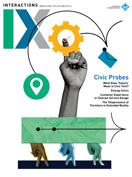Authors:
Elizabeth F. Churchill, Mikael Wiberg
Welcome to the March—April issue of Interactions. As we move solidly into 2024, we have been considering how civic infrastructures, currently and in the future, will affect our experiences with technology, our experiences with services we take for granted, and how we relate to one another. This issue centers around people, digital technologies, and engaged communities from the perspective of civic infrastructures—in short, infrastructures for interactions.
Centering community engagement is something we both believe in heartily. Our cover story, "Civic Probes: A Method That Embeds Questions of Civic Infrastructure and Participation," by Ian G. Johnson and Vasilis Vlachokyriakos, focuses on how we do community-based research. A wonderful introduction to this participatory approach, the article illustrates the value of designing technologies that address critical societal issues and strengthen communities. The goals of the civic probes method include shifting design decision making to include those who will live with the consequences of the technology and highlighting the broader challenges faced by communities, such as environmental issues, social inequities, or gaps in civic participation. Further, instead of focusing on deficiencies, this approach seeks to identify and leverage existing strengths and resources within a community while baking in ongoing evaluation and adjustments based on community feedback. In principle and when done well, this will allow for more adaptable and responsive designs that are situated in the local context. More specifically, Johnson and Vlachokyriakos discuss civic probes designed for a civic technology project across rural villages in Northumberland in the U.K., raising issues related to the governance, accountability, situatedness, value, and timeliness of information and data, and the sustainability or resilience of relevant infrastructures.
In their article "What Does 'Failure' Mean in Civic Tech? We Need Continued Conversations About Discontinuation," Andrea Hamm and colleagues share a provocation around events and academic conferences dedicated to civic tech, where short-term success stories are foregrounded such that long-term perspectives and slower, ongoing (democratic) transformation processes are not investigated and discussed. They invite us to consider looking at failure and discontinuation over the longer term, which can provide key learning opportunities for our community of scholarship.
Focusing on service design and customer experience, Ruth Neubauer takes a slightly different tack on infrastructure. In "Customer Experience in Telecom Service Design: Time to Up the ANT," Neubauer presents a case study of how fractured infrastructures between different parts of a service can disrupt and confuse people, leading to a very bad service experience. She illustrates how frameworks like actor-network theory (ANT) can assist us in understanding customer experience from a holistic perspective. In particular, ANT can reveal where organizational "seams" across different departments with different incentive structures can lead to truly appalling experiences. This approach helps us better understand how we can weave people and their experiences into our service design work.
In Exhibit X, Kieran Woodward and colleagues share the story of their MEMO Project Inscription app, which focuses on fostering community engagement around biodiversity loss.
In What Are You Reading?, Melissa Gregg shares some of her favorite texts. Like us, she is deeply interested in the "full stack," from the hardware layer to interaction design. From Julian Orr's classic Talking About Machines to considerations of the nature of intelligence with James Bridle's Ways of Being, we gain insight into what areas continue to inspire her thinking. We are also thrilled to announce that she will be joining the Interactions team as a columnist.
Finally, in Exit, Arnold Lund offers a wonderful historical example of how great visions can come to naught as a result of contentious and competitive motivation structures. Take a look at an evocative image that captures the history of a long-awaited and much-contested public transportation project from long ago.
As always, we invite contributions of many kinds to the magazine. Please take a look at our submission categories on our website: https://interactions.acm.org/submissions.
Elizabeth F. Churchill and Mikael Wiberg
[email protected]
Copyright held by authors
The Digital Library is published by the Association for Computing Machinery. Copyright © 2024 ACM, Inc.








Post Comment
No Comments Found